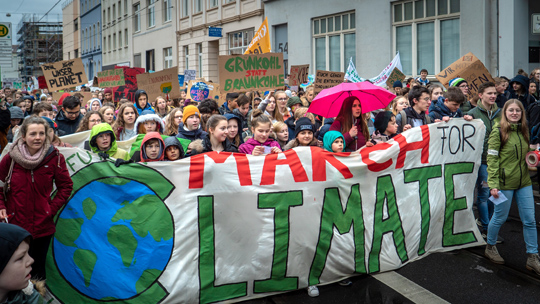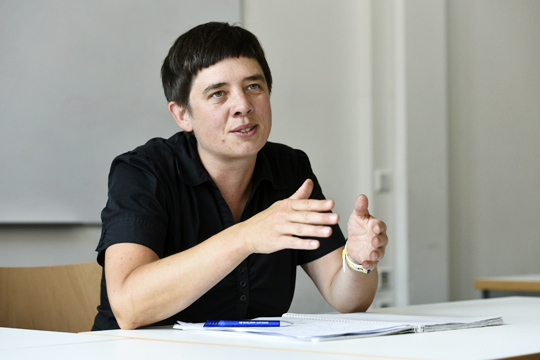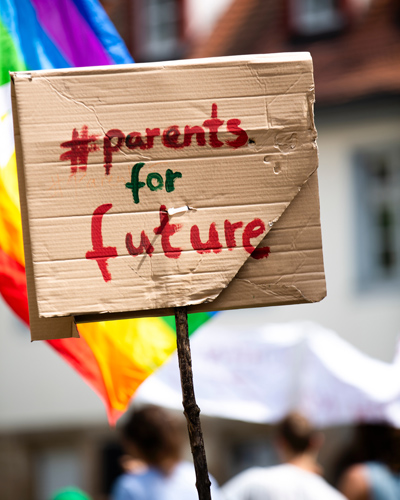Young, Loud, Fast
Freiburg, Aug 13, 2019
It may be the summer holidays right now, but social movements don’t take a break. Something is happening in the environmental movement, says Freiburg historian Dr. Birgit Metzger: long branded as unpolitical, young people have provided a boost. The Fridays for Future initiative stands not only for a sustainable lifestyle, but is also making political demands, especially for the Paris Convention to be upheld. Annette Hoffmann talked with Metzger about the climate issue, the relationship of social movements to political parties and politicized parents.

The Fridays for Future initiative has a young face – however until the 1970s environmental protection was mainly shaped by old men. Photo: Mika Baumeister/Unsplash
Ms. Metzger, you wrote your dissertation on forest dieback. Are you experiencing something like déjà vu now?
Birgit Metzger: Yes, in many ways. A good three weeks ago ‘Forest dieback 2.0’ was announced. Where trees are concerned, collective memory is sharp in Germany. The debate about the environment isn’t new, We’ve had to deal with global problems since the 1970s. Forest dieback was also about emissions that were produced from energy generation, industry and travel. But we are still far from having resolved the basic question of how you can shape modern industrial and consumer societies in an environmentally-sustainable way.
So how does the Fridays for Future movement fit in here?
In the past two years, the environmental movement has received a boost, the debate is not just taking place in the media and in parliament. There were the protests against deforestation of Hambach forest, and in Bavaria the successful referendum on species conservation. And the Greens are currently doing well in elections and surveys. What is new about Fridays for Future is that it is mainly young people who are involved. That wasn’t always the case. For a long time, environmental protection was shaped by old men, youth associations were only founded in the 1980s. But we are still a long way from the degree of mobilization that was reached in the 1970s and 1980s with the anti-war and anti-nuclear movement. Social movements need both a long-term goal and short-term causes.
So what are the characteristics of a social movement?
It’s a form of politics that takes place outside the established parties and associations; it’s formed from the bottom up, loosely organized and minimally defined. A social movement aims to bring about or prevent social change.

“Social movements need both a long-term goal and short-term causes,” says historian Birgit Metzger. Photo: Thomas Kunz
How does a social movement become a youth movement?
What we know about the politicization of young people is that it occurs through their peer group. Early studies into Fridays for Future show that more than 50 percent of the protesters are between 14 and 19 years old, some are early 20s. There has been a trend towards the politicization of teenagers for years. So the recent demonstrations aren’t that surprising. Protest research says that you need a certain amount of economic and social freedom as a requirement for political engagement. This theory is based on the assumption of post-materialism. But I’m not utterly convinced, because the environment and peace also have material effects. One major difference to the 1980s is that the mobilization happens far faster and more easily. There are advantages and disadvantages to this. Protest movements arise quickly, but they can also ebb away quickly. You can see this for instance in the Occupy movement of a few years ago. In addition, social media doesn’t replace real encounters. Young people communicate a lot via chats, but they also have to meet – such as at the large summer camp in Dortmund right now. In terms of media historiography, this is typical: something new is added, but the old doesn’t disappear.
What do you think about the accusations that school pupils are simply skipping lessons and would still board an aircraft for school trips?
The protest began as a school strike, but the school pupils don’t strike the whole time during school term. The school strike was a good way to attract attention and emphasize their seriousness. Yet that’s exactly what is then used against the school pupils. In the environmental debate it’s about an individual attitude and a political attitude. In past years, individual consumption and individual lifestyle were very much in the foreground. But in the end it is a political question. It’s too easy to delegitimize people, by accusing them of not being consistent.

Uniting generations: parents support their children’s protest – and see their political engagement as a sign of a good upbringing. Photo: Markus Spiske/Unsplash
The media played a part in the forest dieback campaign. Is that happening again today?
The media are extremely important. They like to pick up on protest issues. As far as the environmental movement is concerned, they often sympathize. In the end, the media structure debates, they are capable of pushing certain themes to the fore. The media like to use personalization, but that isn’t right for the movement, because it is formed in a very fundamentally democratic way.
Is a meeting of generations important for the climate issue?
It’s already happening. Parents are also being politicized. Most of them welcome their children’s protest and see it as a sign of a successful upbringing. Bridge-building is important for social movements, but they have to be the right ones. Environmental protection is very heterogeneous politically. Until the 1960s, for example, it tended to be more conservative, somewhat national even. You have to think hard about which associations fit, and it’s important to maintain a form of independence, otherwise the movement would lose its critical edge.
Wouldn’t it be a good strategy for parties to rejuvenate by taking the protests seriously?
Absolutely! In historic terms social movements have always done something with parties. There are always activists who conclude that you can influence political decisions through parliamentary democracy. Another part remains independent.
So what do you predict for the autumn?
It will continue. The question is how, and whether the protest will become more international. The call is for the next strike week to be worldwide in September.

